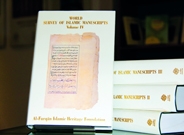|
| Contact: | Sheshi Skënderbej, Tirana 1000 |
| Telephone: | 355 4 222 3843 |
| Date of establishment: | 1920 |
| Status: | Institutional |
| Status Details: | National library |
| Condition of access: | Credentials required. Written application by an Albanian scientific or university institution, based on a scientific, cultural, educational or library agreement between two countries. Opening hours: Monday to Saturday 08.00-20.00 Sunday 08.00-14.00. |
| Total number of Islamic MSS: | 479 (370 Arabic; 132 Turkish; 38 Persian; incl. 61 Arabic & Turkish, Arabic & Persian, Turkish & Persian and Arabic, Turkish & Persian). |
| Description of Collection: | Two MSS date from the 11th and 14th centuries, 21 from the 15th century, 31 from the 16th century, 47 from the 17th century, 111 from the 18th century and 65 from the 19th century. The others are undated. In these collections are Islamic MSS of the last quarter of the 18th century and the first quarter of the 19th century collected by the autonomous rulers of Shkodra, the Vezirs Kara-Mahmut Pasha Bushati or Bushatasi (Bushatlli) (1749–1796) and Mustafa Pasha Bushati (1796–1860). These include very ancient and interesting MSS, of artistic value for their bindings, illustrations and calligraphy. They indicate the existence of a very old tradition of creation, copying and preservation of Islamic MSS in the Albanian territories. Among the Persian MSS, literary texts predominate, mainly poetry, such as the well-known Bustan, Gulistan, Baharistan, Majnun va Laylá, Ḥadiqat al-Suʿadaʾ and many Divans, etc. of authors like Saʿdi, Adib Ţiflisi, Qasim Anvari, etc. Religious, juridical and philosophical subjects also predominate among the Arabic and Turkish texts, but there are literary and linguistic writings, too, as well as some on natural sciences. Among the religious items are Qurʾans, tafsirs, Mevluds, religious advice, etc. Many of them are from the Bektashi order. Most of the juridical items are on property division according to the Shariʿa. The philosophical works are devoted mainly to logic and aesthetic problems, including the treatise on logic by Ibn Sina (Avicenna), Kitab al-Isharat (890 H/1485 CE), 122 leaves. Other authors include Ibrahim Halebi (several MSS); Ibn Malik and Sayyid ʿAli. The following also may be especially noted: – Al-Jarabardi, Ahmad: Commentary on Ibn al-Ḥajib's Al-Shafiya. 976 H/1568 CE. 160 folios. – Al-Sayyid al-Sharif: Sharḥ al-Miftaḥ. 879 H/1473 CE. 217 folios. – ʿUbayd Allah ibn Masʿud: Tanbih al-uṣul. 3 MSS, 840 H/ 1436 CE. 178 folios. – Ṣerh-i Vakayi. 997 H/1588 CE. 194 folios. – Emin, Abdullatif: Ṣerh-i Macma ul-Bahreyn. Amasya, 869 H/ 1464 CE. 515 folios. – Al-Suyuṭi, ʿAbd al-Rahḥman. Al-jamiʿ al-ṣaghir. 907 H/1501 CE. 123 folios. Hashiyat al-Sayyid ʿAli ʿala Sharḥ-i Dibajah-ʾi Miṣbaḥ. Elbasan, copied by Sayyid Qasim, 976 H/1567 CE. – Jami, ʿAbd al-Raḥman: Sharḥ ʿala 'l-Kafiya. 165 leaves. Many MSS are distinguished by their calligraphy, and some have illumination, illustrations or fine bindings. |
| Published Catalogues: | 0 |
| Unpublished Catalogues: | 0 |
| Online access: | www.bksh.al |
| Bibliographical appendix Total: 3 | 1961 |
1971 | |
1982 |
Cities surveyed
Libraries surveyed
Catalogues surveyed

